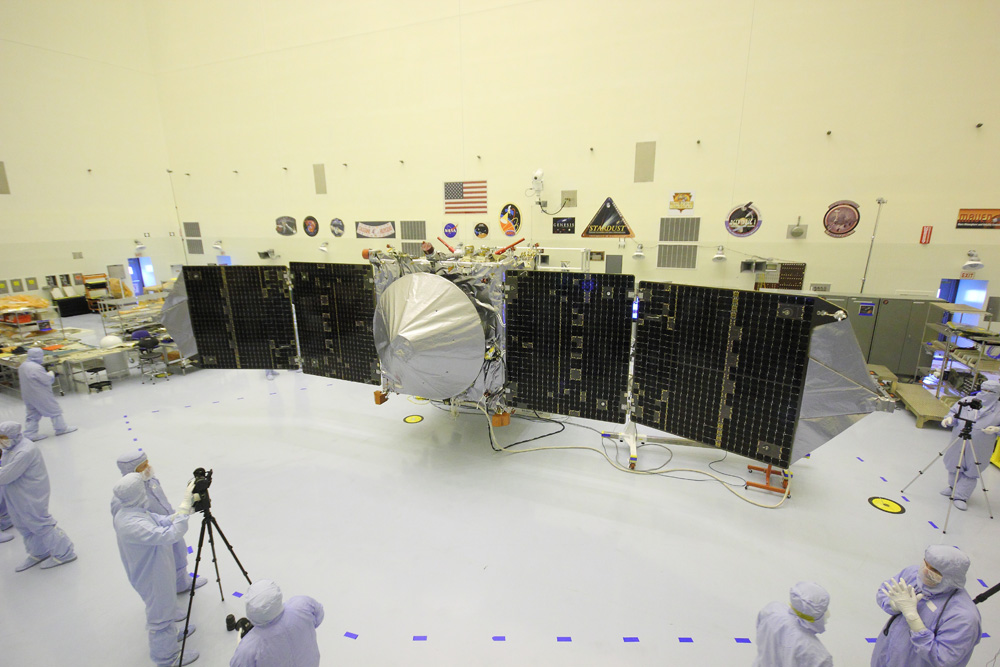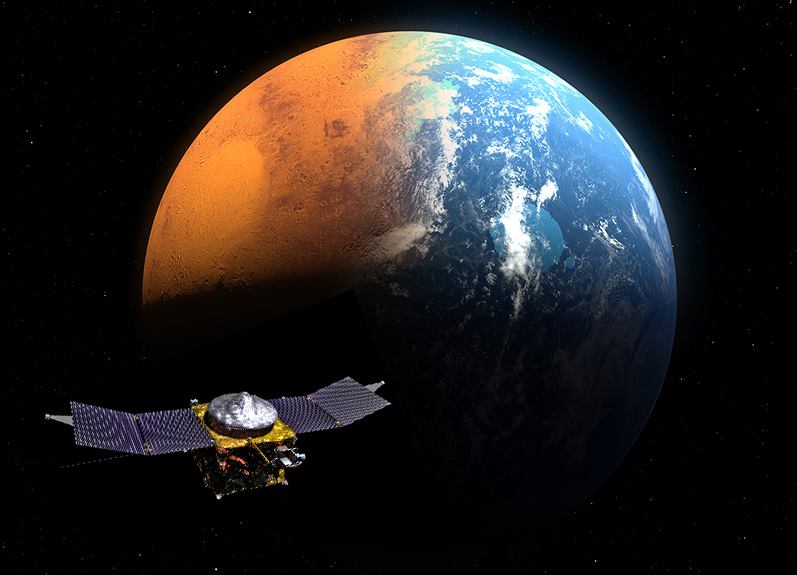
Story updated with additional comments from the science principal investigator
Sometimes you have to take the plunge to get the precious experiences you desire.
So it is with NASA’s newest Mars orbiter, MAVEN, which just completed its first planned plunge deep into the Martian atmosphere “to give us the best possible broad understanding of the behavior of the system,” Bruce Jakosky, MAVEN principal investigator at the University of Colorado’s Laboratory for Atmospheric and Space Physics in Boulder, told AmericaSpace exclusively.
A series of five “deep dip” plunges by MAVEN over the next year will help elucidate unprecedented clues on Mars‘ climate history and determine why the Red Planet lost most of its atmosphere and water over the past four billion years.
“The deep dips are spread out later in the mission, capturing other specific geometries so that, combined, they give us the best possible broad understanding of the behavior of the system,” Jakosky explained to AmericaSpace.
These observations have huge implications for the astrobiological potential at the Red Planet.
This week the Mars Atmosphere and Volatile Evolution (MAVEN) spacecraft conducted its first “deep dip” campaign down into the upper reaches of the planet’s lower atmosphere.
Engineers commanded MAVEN to start firing its on board maneuvering thrusters on Feb. 10 for the first of three planned maneuvers to lower its periapsis, the lowest altitude in the orbit, by about 25 km (16 miles).
The goal was to decrease MAVEN’s nominal altitude sufficiently so that its suite of science instruments could gather unique measurements down to the top of the Red Planet’s lower atmosphere at the interface with the upper atmosphere where it normally resides.
“During normal science mapping, we make measurements between an altitude of about 150 km and 6,200 km (93 miles and 3,853 miles) above the surface,” said Jakosky in a statement.
“During the deep-dip campaigns, we lower the lowest altitude in the orbit, known as periapsis, to about 125 km (78 miles) which allows us to take measurements throughout the entire upper atmosphere.”
The $671 million MAVEN spacecraft’s goal is to study Mars’ tenuous upper atmosphere in detail for the very first time by any spacecraft and to explore the mechanisms of how the planet lost its atmosphere and life-giving water over billions of years, as well as determine the rate of atmospheric loss.
Were all nine instruments involved in deep dip science gathering?
“All nine instruments were making observations throughout the deep-dip campaign, along with NAV tracking of the orbit to determine periapsis density and use of the spacecraft accelerometers to derive density structure,” Jakosky explained to AmericaSpace.
“Everything worked as planned, and we have data from all instruments.”
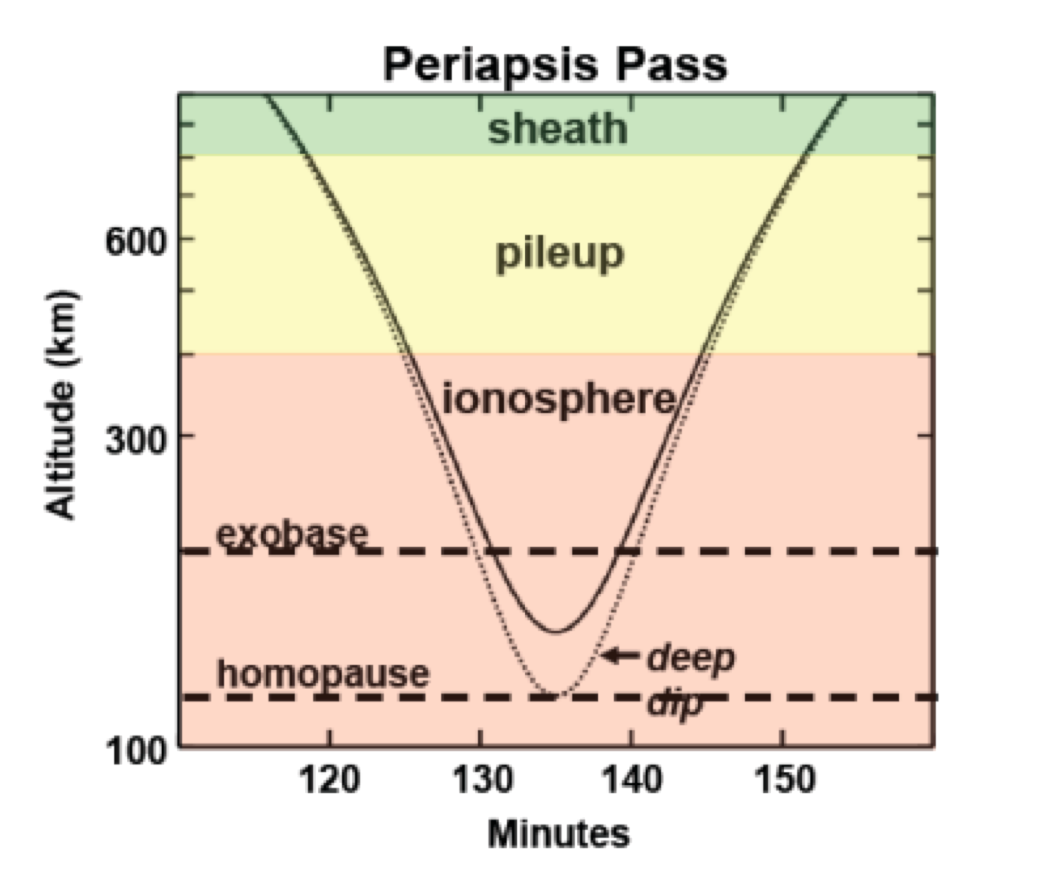
At first glance a difference of merely 25 km (16 miles) altitude may seem minor. However, by plunging down to about 125 km (78 miles), MAVEN will encounter atmospheric densities that are more than 10 times what they are at 150 km (93 miles).
“We are interested in the connections that run from the lower atmosphere to the upper atmosphere and then to escape to space,” said Jakosky. “We are measuring all of the relevant regions and the connections between them.”
So it’s precisely because of the 10-fold increase in atmospheric density and increase in drag that the normal mapping altitude is higher to prevent relentless spiraling down and harm to the spacecraft’s equipment and instruments from frictional heating.
Therefore, the science team only plans a total of five “deep dip” campaigns throughout the primary mission duration of one year.
“MAVEN’s goals are to understand the role of the loss of Mars atmosphere, try to understand the energy inputs into the upper atmosphere from the sun and the solar wind, determine the response of the upper atmosphere to that and effects of the energy inputs, and understand the processes that led to the escape of the atmosphere over time,” says Jakosky.
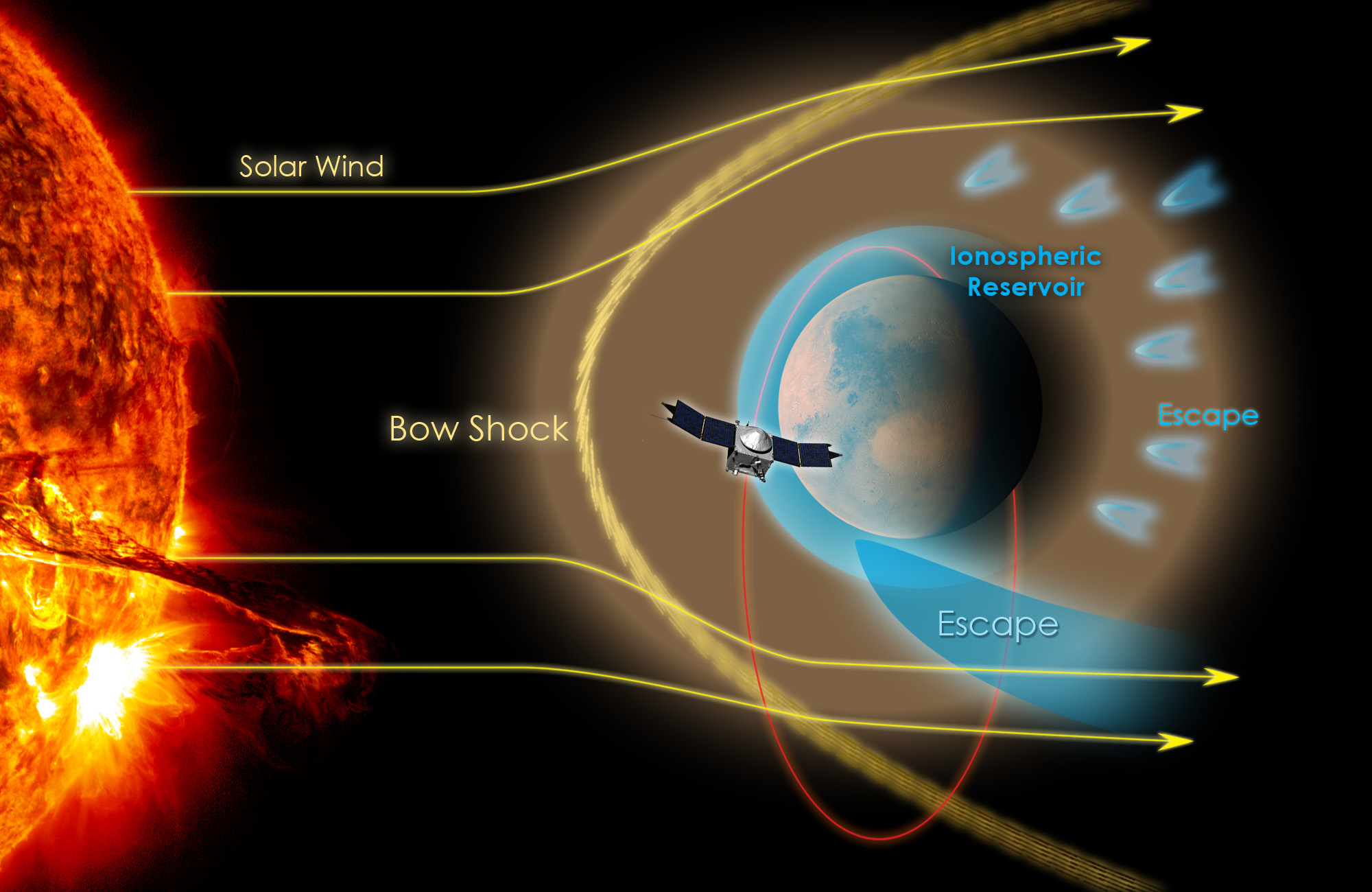
Overall, the first deep dip campaign ran from Feb. 10 to Feb. 18.
The trio of initial engine firings to lower MAVEN’s periapsis were completed gradually over three days to ensure everything went as planned with no surprises. So it was “walked” down gently in several smaller steps and actually aimed to reach a specific atmospheric density for science observations.
“Although we changed the altitude of the spacecraft, we actually aimed at a certain atmospheric density,” said Jakosky. “We wanted to go as deep as we can without putting the spacecraft or instruments at risk.”
Then the orbiter spent a total of five days and 20 orbits observing the entire upper atmosphere from top to bottom.
“Some instruments were turned off during parts of the deep dip; for instance, the IUVS cannot operate at the high densities during the deep dip, so was turned off near periapsis on each orbit,” Jakosky told AmericaSpace.
Since the planet rotates under the spacecraft, the 20 orbits allow sampling of different longitudes spaced around the planet, providing near global coverage.
At the end of the five-day observation period, a pair of thruster firings returned MAVEN to its nominal mapping altitude.
“The two maneuvers were carried out Tuesday and Wednesday, with a day in between to track the spacecraft and determine what our periapsis density was. Thursday, we declared ourselves fully done,” Jakosky told me.
When is the next deep dip?
“The second deep-dip campaign is scheduled to start on April 14,” Jakosky replied.
Will it be making any different types of measurements?
“At that time, periapsis will be very close to the subsolar point on the planet, so we’ll get the best observations of the dayside ionosphere and upper atmosphere. Of course, this date is subject to operational considerations that could affect our carrying it out on schedule.”
“The remaining three deep dips are spread out later in the mission, capturing other specific geometries. Combined they give us the best possible broad understanding of the behavior of the system.”
All the data will be used in concert to refine our understanding of the evolution of Mars’ atmospheric and water history and the implications for astrobiology.
“The mission is going smoothly, and the data are spectacular!” notes Jakosky.
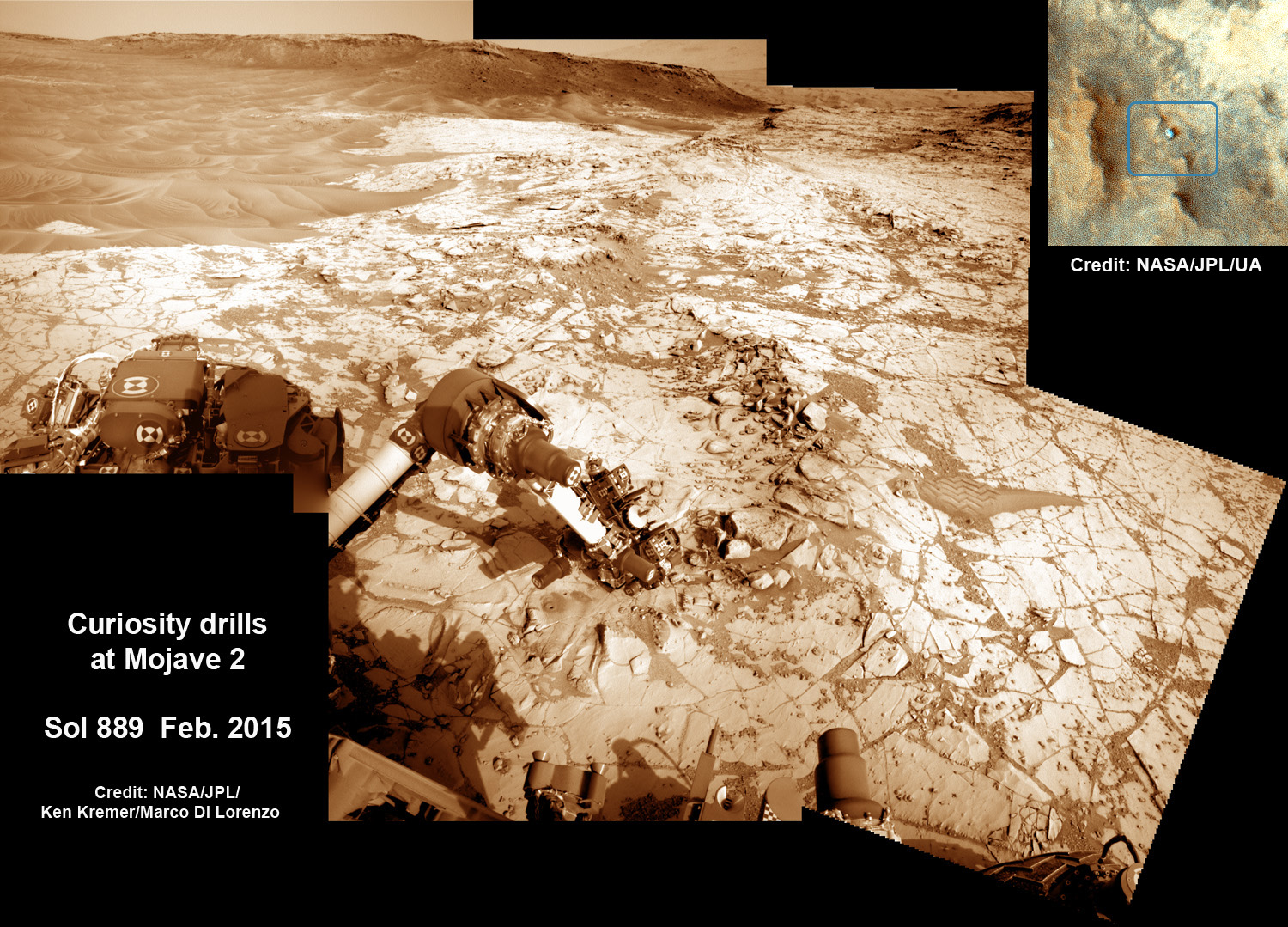
And initial science results will be presented at a planetary science conference in March.
“We’re planning to try to put it together into a coherent picture of the upper atmosphere in order to present it at the Lunar and Planetary Science Conference in mid-March. That will be the first time that we have real ‘preliminary science results from the MAVEN mission’!”
The 5,400-pound MAVEN probe carries nine sensors in three instrument suites to study why and exactly when did Mars undergo the radical climatic transformation.
MAVEN’s observations will be tied in with NASA’s ongoing Curiosity and Opportunity surface roving missions as well as MRO and Mars Odyssey to provide the most complete picture of the fourth rock from the Sun that humanity has ever had.
MAVEN thundered to space on Nov. 18, 2013, following a flawless blastoff from Cape Canaveral Air Force Station’s Space Launch Complex 41 atop a powerful United Launch Alliance Atlas V rocket.
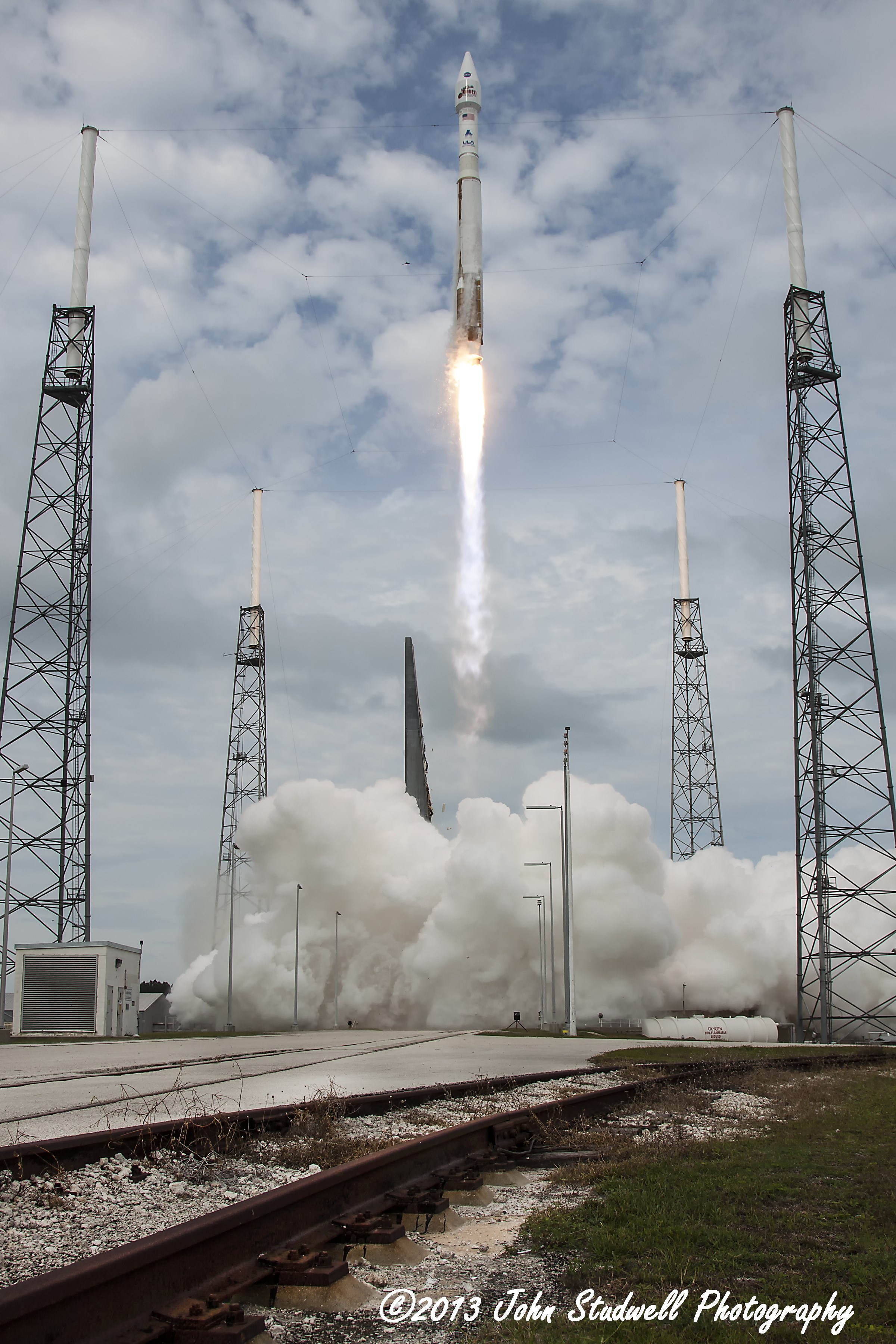
MAVEN, along with India’s newly arrived and first-ever interplanetary probe the Mars Orbiter Mission (MOM), joins a record breaking armada of seven Earth spacecraft exploring the Red Planet.
Stay tuned here for continuing developments regarding Earth’s “Missions to Mars.”
Want to keep up-to-date with all things space? Be sure to “Like” AmericaSpace on Facebook and follow us on Twitter: @AmericaSpace
